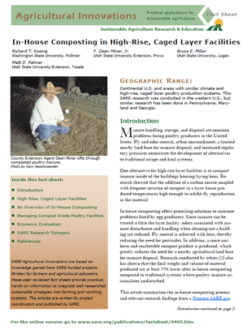The goal of SARE research project in-house composting in high-rise, caged layer facilities was to develop operational parameters for in-house composting. Specific objectives were to: 1) evaluate carbon source, rate, and turning frequency variables for their effects on compost temperatures; 2) evaluate amendments and process controls to reduce ammonia volatilization from composting manure; and 3) conduct a partial budget economic analysis of in-house composting relative to traditional methods of handling and disposing of poultry manure.
The research was initiated in 1998 at a 330,000-layer egg farm and later expanded to a second facility of similar size. Both farms were located in central Utah and featured high-rise, caged layer buildings. Each building housed approximately 65,000 laying hens. The manure accumulation area in each building was divided into multiple quadrants and treatments applied to separate quadrants in a randomized complete block experiment design. Each treatment was replicated three times within a building.
Two trials were conducted to evaluate the effect of carbon rate and turning frequency on compost temperatures. Trials indicated that initial carbon rates of 200 to 600 lbs per 1,000 square feet of floor area were adequate to achieve critical temperatures for fly control as long as material was turned at least once every three days during early stages of composting. Wheat straw and sawdust were equally effective as carbon sources.
Trials demonstrated the importance of turning frequency to maintain high compost temperatures. Temperatures peaked on the day of turning and declined rapidly thereafter. A turning frequency of once every two to three days was essential to maintain high in-house compost temperatures in layer manure. We also found that rotating fresh manure with live larvae from the surface to the interior of the pile enabled heat to kill the larvae. Longer intervals between turning events could be used later in the composting cycle when higher volumes of compost were present.
In-house composting with manure from young birds (pullets) was generally unsuccessful due to the higher moisture content of pullet compared to layer manure. Two additional trials were completed evaluating the effects of turning frequency (three or six days per week) and carbon rate (400 or 800 lbs/1,000 square feet of floor area) on composting pullet manure. Results indicated that increasing the turning frequency could accelerate pullet manure drying and increase compost temperatures. Doubling the rate of carbon was less effective than increasing turning frequency.
In all of these studies, the C:N ratio of composting material was in the range of 10 to 12:1 throughout a cycle. Composting with low C:N ratios generated high levels of atmospheric ammonia within the poultry facilities. While no reductions in egg production or increases in bird mortality were noted, high ammonia levels were a health concern for workers and poultry.
Initial efforts to control atmospheric ammonia were focused on documenting the spatial and temporal variability of ammonia inside high-rise facilities during composting. Atmospheric ammonia levels were shown to vary spatially within the buildings, with higher concentrations found near the center of the building away from ventilation fans. Concentrations frequently exceed 25 ppm ammonia (the upper limit for eight-hour exposure of workers) in the manure storage area. Atmospheric ammonia concentrations were approximately 50% lower in the cage area. Spikes in atmospheric ammonia exceeding 35 ppm (the upper limit for 10-minute exposure) occurred immediately after a compost turning event and lasted for less than 60 minutes. Ammonia levels also increased over time as compost volumes increased. In a series of laboratory and limited in-house trials, process controls and chemical amendments such as aluminum sulfate showed potential to reduce ammonia volatilization from composting poultry manure.
